Some of the links in this post may be affiliate links.
I’ve become totally obsessed with the Rhipsalis genus of plants. In this post, I’m showcasing Rhipsalis campos-portoana, but the care and tips (including propagation) apply for all Rhipsalis species so you are in the right place! Keep reading to learn about tips on how to grow these unusual, and beautiful jungle cacti.
It really is a stunning, easy to care for genus of plants, and every houseplant collection needs to have at LEAST one!
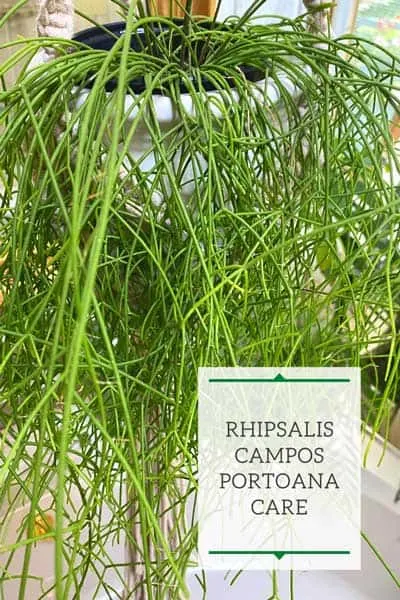
Table of Contents
ABOUT RHIPSALIS
Before getting into 7 important care tips on growing Rhipsalis, I have a few important topics to briefly bring up.
Rhipsalis species are commonly called Mistletoe Cactus and truly are cacti, except these cacti grow in the jungle and not the desert. Not only that, they are epiphytes, so they actually grow on tree trunks and branches and not on the jungle floor in the soil.
The term “mistletoe cactus” is commonly used for R. baccifera, but many times, it is used for any species in the genus. This is why I like to stick with the scientific name so that we know exactly which species we are talking about!
Another point of clarification is that the Mistletoe plant that we are familiar with during the holidays is NOT a Rhipsalis…so this further contributes to the confusion with common names.
Rhipsalis campos-portoana is native to Brazil. There are about 40 species of Rhipsalis and they’re mostly all native to various areas of Central and South America. They are also found in some areas of Africa and Asia.
RHIPSALIS CARE
Although Rhipsalis plants are actually cacti, they are jungle cacti so their care is quite different from your common prickly desert cactus.
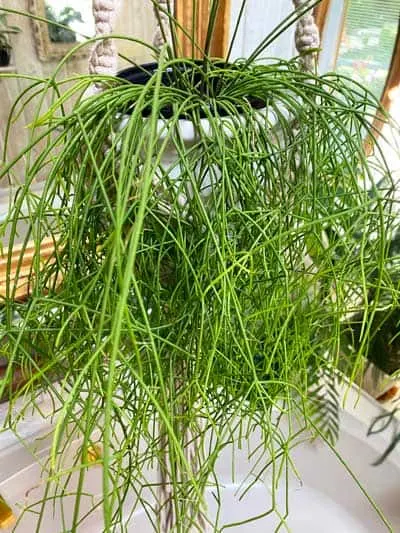
1. LIGHT
These pendulous epiphytic jungle cacti naturally grow attached to tree trunks and branches and dangle freely in the air. As a result, you can imagine that they grow in dappled light that is filtered from the jungle canopy.
How does that translate in our home environment? Remember that light inside our homes is reduced from what it would be outdoors, so a little bit of direct sun would be beneficial for growth.
Morning sun is preferred, but these are NOT plants that can take full sun otherwise they will scorch. Eastern exposure windows that provide morning sun are ideal.
I’ve found that North windows (in the Northern hemisphere) are a bit too dark in general. They will grow, but growth will be weak. If you have really sunny windows, diffuse the light with blinds or sheer curtains.
My own Rhipsalis campos-portoana hangs in my sunroom right under a skylight. On a good day, depending on the season and cloud cover, it can receive anywhere from no direct sun to 2-3 hours of sun.
These plants actually flower as well, but they will only flower if there is sufficient light.
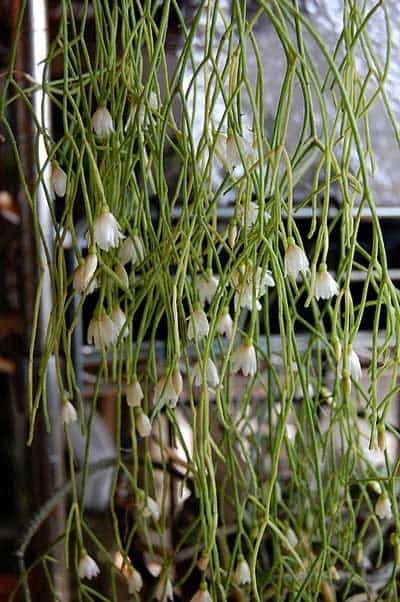
If you see that the stems are turning reddish, this just means that the plant is at the higher end of its light tolerance. A little red is ok, but be aware of this!
I saw this on my own plant when I placed it to grow under a grow light. I had the plant on a Northern window at one point and it wasn’t very full. Once I placed it under a grow light, it really took off!
The plant got much more full and grew more prolifically. It was placed maybe a foot under a Sansi 70W Full Spectrum LED Grow Light that I purchased on Amazon. I was amazed at how quickly the plant responded with thicker, sturdier, and more growth.
My Rhipsalis did turn a little reddish from the increased light, but it wasn’t bad at all.
I have since moved the plant under a skylight where it has been very happy. Had I kept the plant under the light, I would maybe have kept it more like 2 feet under the light to be safe.
2. WATERING and FERTILIZER
In nature, these plants have adapted to go through cycles of being wet and dry. Although they can go through periods of very wet weather, since they are epiphytes that live in trees, their roots have a lot of air circulation and have naturally great drainage.
In the home, try and avoid extremes in moisture. Regular watering is important, but avoid overly wet conditions, especially avoid having your plant sit in water for extended periods of time.
Rhipsalis in general is not a drought tolerant plant though, so try and not let your plant go completely dry, especially for long periods.
I’ve noticed that when I went too long without watering, some of the stems would just fall off. If you see portions of the stems falling off, immediately check the soil moisture and water immediately if it is too dry.
As far as fertilizing, I fertilize with Dyna-Gro Grow and have gotten fantastic results. I always keep a good stock of this fertilizer from Amazon and use this for the majority of my plants.
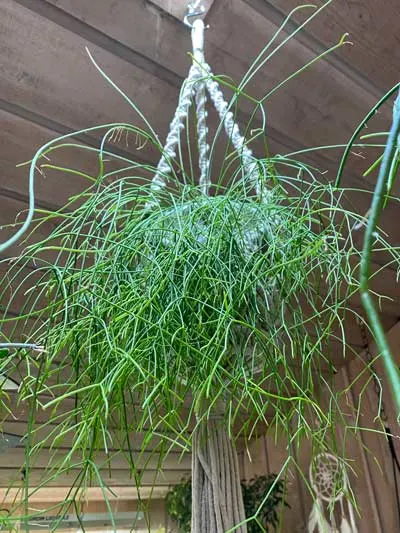
3. SOIL
Since these are epiphytes, it is important that they have a sharply draining potting mix.
My own Rhipsalis plants grow in a 2 part cactus soil mixed with 1 part pumice. The drainage is amazing and plants are growing nicely.
There is no one, magic potting mix though.
You can vary your potting mix, and as long as it drains quickly and dries out easily between watering, you are good to go. I know of some people that also successfully use equal parts of potting soil, orchid bark and perlite.
4. TEMPERATURE and HUMIDITY
Being jungle plants, Rhipsalis like it warm and humid. I’d recommend no lower than a minimum of 60F temperatures at night, and of course warmer temperatures during the day.
I’m normally not a fan of misting because it does not increase humidity, but misting is GOOD for epiphytes since they do get some of their water requirements through their leaves. So mist away!
For more details on humidity, check out my blog post on how to increase humidity for houseplants. I also talk about one of my favorite humidifiers that I highly recommend.
5. POT SIZE AND TYPE
Rhipsalis like to grow in tight quarters so you should grow them in relatively small pots. Take care not to overpot them.
When you do go up a pot size, only do so if your plant is very root bound.
I have various Rhipsalis in both plastic and clay (terra cotta) pots. Just be aware that terra cotta pots do dry out much more quickly, so depending on your watering habits, you can choose a pot type that will suit your needs and routine.
Check out my blog post on pros and cons of terra cotta pots to see if they are right for you!
6. PESTS
In good conditions, plants are generally pretty pest free. I’ve never had problems with pests with my Rhipsalis, but if you have really warm and dry air, it can encourage some pest issues. Particularly spider mites, mealybugs and thrips.
If you do see these pests, use either insecticidal soap or Neem Oil to treat. Use per the label instructions, and be sure to rinse off with plain water in between applications in order to keep the residue from building up and harming the plants.
7. PROPAGATION
Rhipsalis campos-portoana is super easy to propagate. Take a look at my plant below. The left part of the photo shows when I received cuttings from a friend and potted them up. The right side is the same plant just a little over 2 years later.
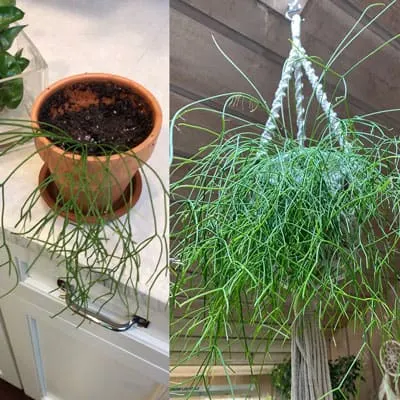
The cuttings that I used in the left hand side of the photo above were pretty long, but I could have cut them down further and had more cuttings.
And here is the same plant (on the left in the photo below) about 6 years after starting from cuttings. This plant is now in my greenhouse. To the right of the Rhipsalis is a Hoya curtisii.
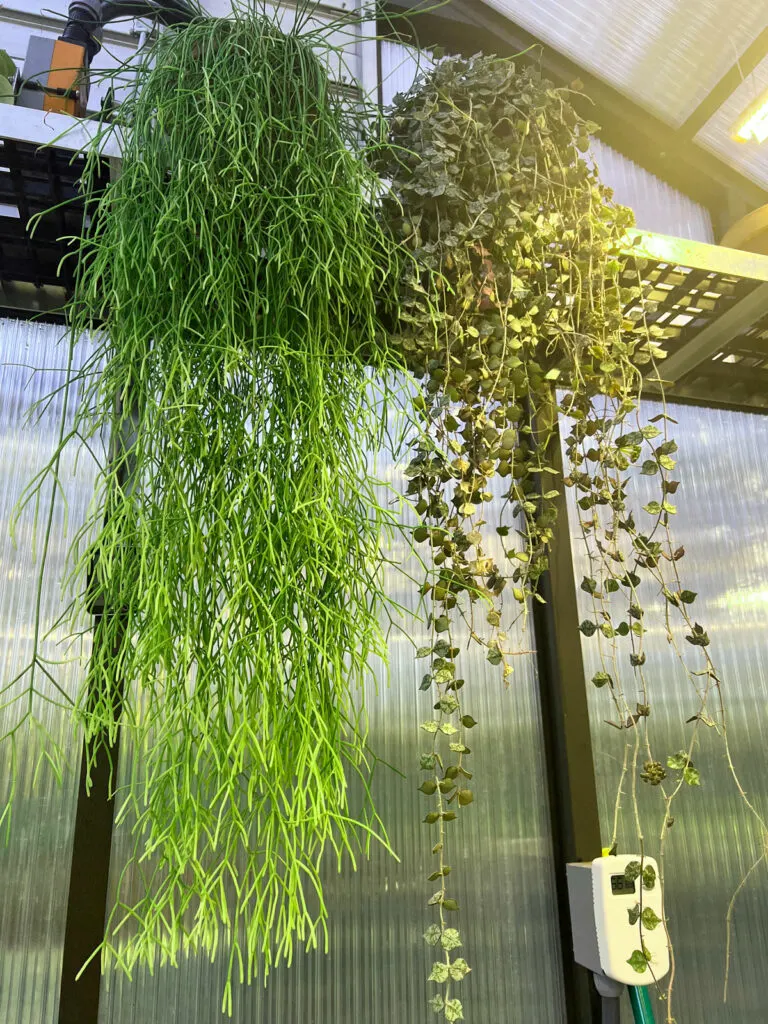
To propagate, simply snip off some cuttings (make them at least 3 inches long) and let the cuttings air dry for a couple days. (Make sure that you don’t turn the cuttings upside down though when you pot them up or they will not root!)
If you have any really long, awkward stems, these are ideal candidates to make cuttings from!
Insert the cuttings into a small pot of soil. I lightly watered the pot and allowed it to go dry, and then repeated. Don’t start watering regularly until the plant is rooted and is starting to grow.
It really is that simple! If you’d like more details, check out my post on how to propagate Rhipsalis.
RHIPSALIS TOXICITY
Rhipsalis is non-toxic to cats and dogs according to the ASPCA.
Do you have any Rhipsalis campos-portoana or any other Rhipsalis? Comment below. I’d love to hear! If you want to explore other varieties, check out my blog post on Rhipsalis varieties to add to your collection.

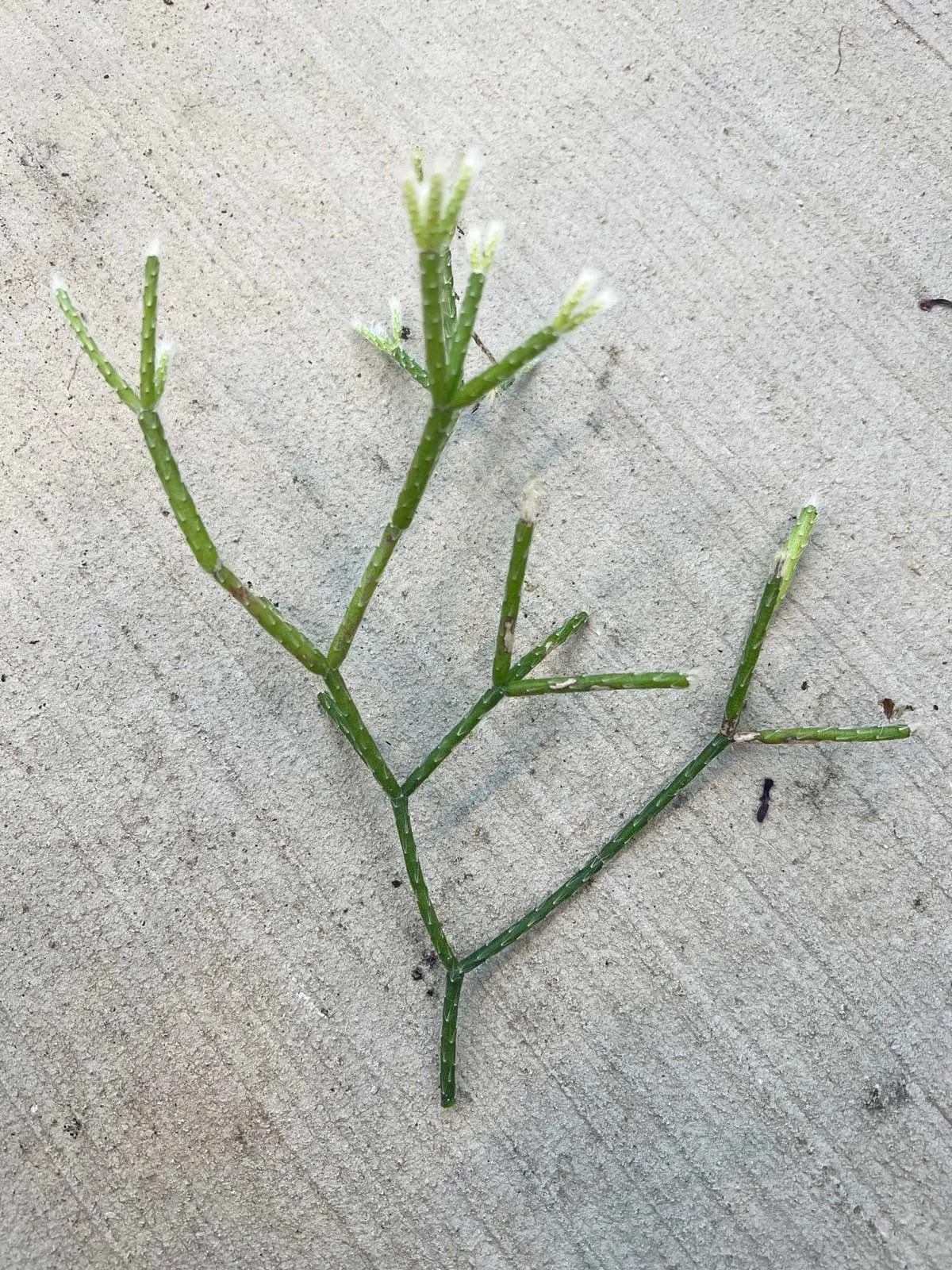
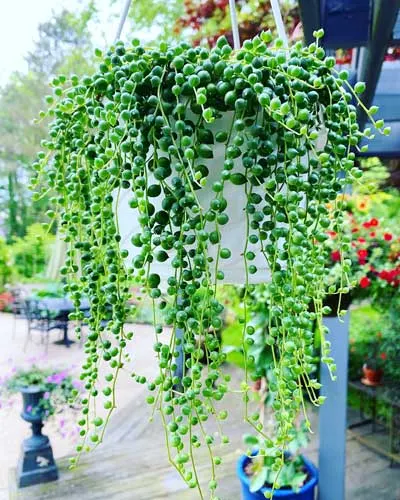
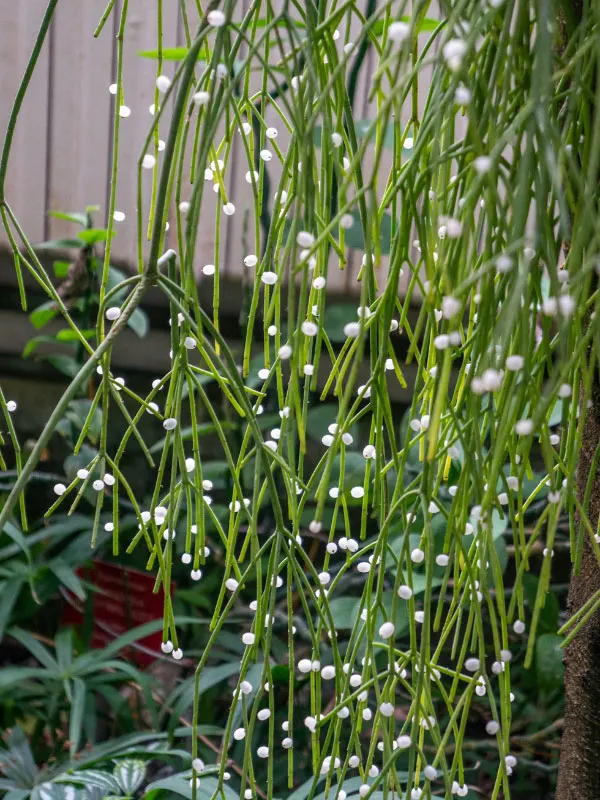
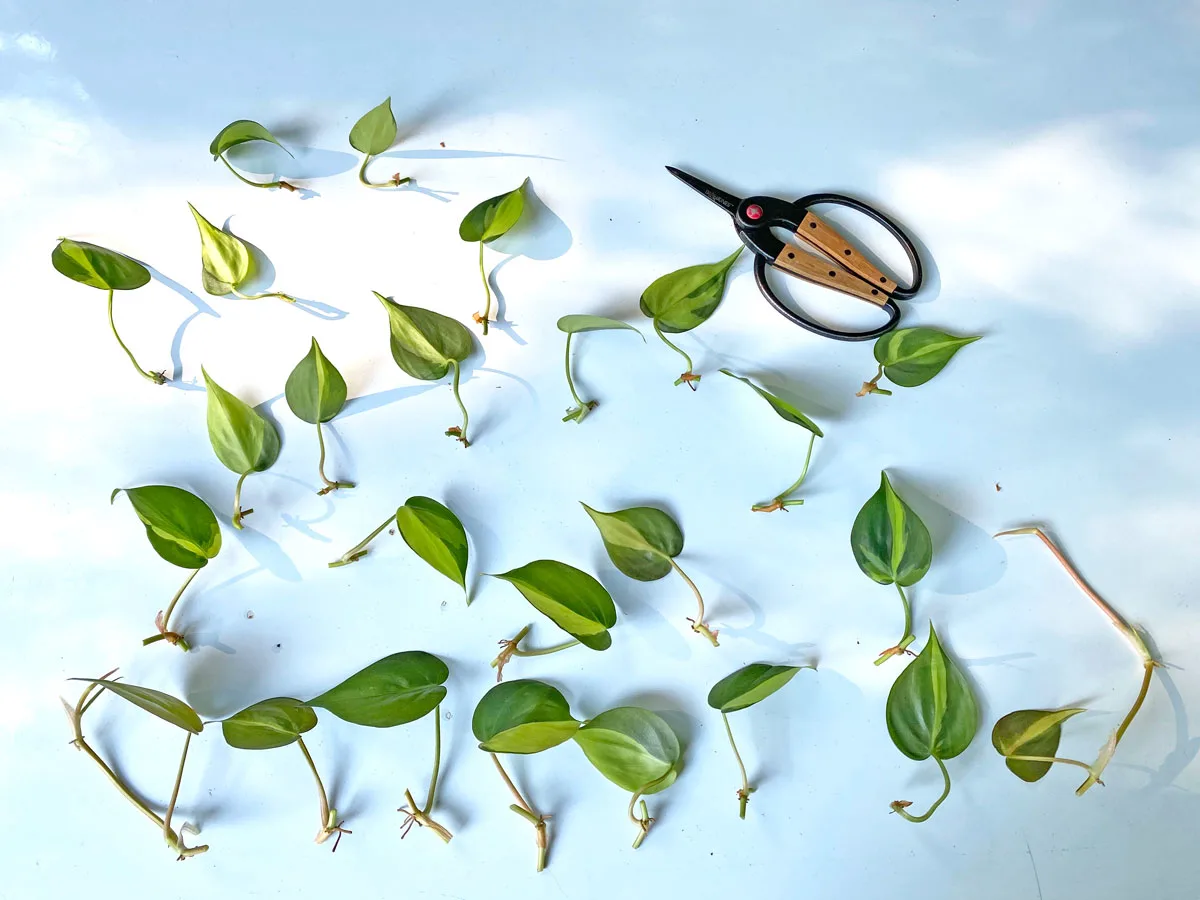

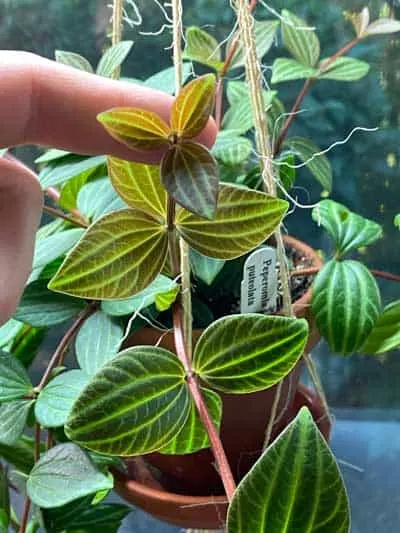
Lauren T.
Thursday 18th of March 2021
Hello, I am trying to save the ones that I have now. I cut off the root rot from previous if I just let them callous can I just plant them in soil that way? I don’t understand what you mean by not putting them upside down.
Raffaele
Wednesday 24th of March 2021
Yes, you can plant them right into soil after letting them callous over. What I meant about not planting them upsidedown is that when you take cuttings, keep them in the same orientation as how they were growing.
Josh
Saturday 9th of January 2021
Picked up an R. baccifera the other day and it's already sparked an epiphytic cactus collection. Bought an Epiphyllum and Selenicereus the next day and I've got some Lepismium and Disocactus cuttings lost in the mail. I think I've discovered that my favorite cacti are the ones that don't look like cacti. Thanks for the care info!
Raffaele
Monday 11th of January 2021
You're very welcome! I'm in the same boat as you are. Epiphytic jungle cacti are awesome plants and more satisfying to me than their desert cousins :-)
Barb
Wednesday 23rd of September 2020
Absolutely perfect article about Rhipsalis sp. I do have a Rhipsalis that has survived despite my neglect. I am not proud of that by the way. With your article I think my Rhipsalis will not just survive but will now thrive. Many thanks! I do have a question. Lighting in my house is terrible so could I move the plant to a West window for 2 or 3 hours a day then back to a more subdued lighting spot for the remainder of the day. Bad idea to switch locations daily?
Raffaele
Wednesday 23rd of September 2020
Hi Barb! I'm glad you enjoyed the post! If it's only 2-3 hours of sun, why won't you try that and see how it goes. Monitor your plant closely. It would be too much work to constantly move the plant (in my opinion!). Where do you live? Depending on where you are at, that west window might be a great location for your plant.